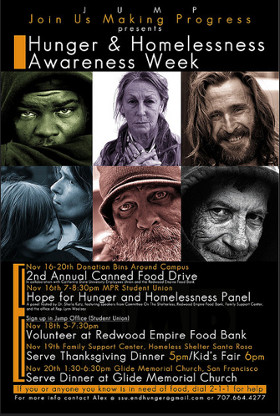
The book we see over on the right-hand side of the page here, Looking Up at the Bottom Line, is really several books in one. It’s kind of an activist-how-to manual, as well as a history of the struggle for social justice as carried out (non-violently and always with a certain flair) in several different places where Richard R. Troxell has lived, particularly Austin, TX. It lays out the rationale behind the Universal Living Wage, and makes the case for why the ULW should be implemented.
It’s also the place where many individual stories can be found, starting with Richard’s own. Coming back from the Vietnam conflict, he tried college, and then got a bit unbalanced after his father’s death. Like so many other young people have done, he ranged around the country, living in a car, a truck, and even a cave. Out west, he worked as a trail restorer and a firefighter, then bounced back eastward to live as a squatter in a house in a derelict area.
As time went on, Richard settled for a while in a rental house with several other guys, and eventually got married and learned everything there was to know about striving for a home of his own. Not content with that, he set about an ambitious project for reviving an entire neighborhood, and branched out from there into many other public-spirited projects.
As well as his own story, Richard gives us portraits of his various mentors and role models along the way, especially the incomparable Max Weiner, founder of CEPA (the Consumer Education and Protective Association) and the Consumer Party. Then, there are little pocket biographies of a number of people experiencing homelessness in Austin, where Richard founded House the Homeless.
There’s Chris Byrt Lyne, who was a construction worker until he was assaulted and suffered a head injury, and Jaime Maldonado, who was already just barely hanging on when serious dental problems sent his life into a downward spiral, and Kenneth Wayne Staggs, whose work-related injury may prevent him from ever earning a living again, even if a job were available.
Ronald Keith Johnson was held back by dyslexia all his life, but worked as a house painter until an on-the-job injury disabled him. James Hawkins underwent open-heart surgery at age 46, but it was unsuccessful, and he was rendered unemployable. Veteran Eugene Golden, like so many other Americans, lost his home through foreclosure. In these pages is the story of Edward Forrest Dutcher, a casualty of the streets who died around this time last year.
Not to disrespect the men caught in the cycle of homelessness, but the stories of homeless women are particularly distressing, like that of Camee Vega, who escaped with her two daughters from an abusive husband and went on to work at the Homeless Resource Center. And as we’ve mentioned before, there’s the tragic story of Diane Malloy, whose needless death inspired the inauguration of Austin’s annual Homeless Memorial Service.
A few of the thousands of people experiencing homelessness have someone like Richard to tell their stories. There is help and encouragement — for instance, last year, graduates of the prestigious Iowa Writers’ Workshop started a writing class for such folks. Thanks to the Internet, many of the homeless are able to relate their own histories online and even publish the tales of their lives.
For The Huffington Post, Gabrielle Canon recounted the life of Carey Fuller, homeless mother of two, and author of the self-published Writings from the Driver’s Side. Canon says,
Fuller was cast into homelessness after the birth of her second child, when she could no longer afford rent as a single mother… Sensing she would soon be on the street, she used the last of her income — a $2,000 tax refund — to purchase the Winnebago… Each day she faced a reality of sleepless nights and life on the move. She worked the midnight shift, printing newspapers for $8 an hour while her two children slept inside their old RV in the parking lot outside.
The only thing unusual about this story is that it isn’t unusual at all. According to the National Coalition for the Homeless, around 600,000 American families find themselves experiencing homelessness. And something needs to be done.
Canon says,
This is why Fuller continues to write, to spread her message to others who may be going through something similar, or who may not understand what homelessness in America is really like. She encourages other homeless parents to do the same.
One thing that could be done, that would help a lot, would be the adoption of the Universal Living Wage. The sad fact is, even a person working a full-time job, at minimum wage, can’t afford housing. This is economic homelessness. The benefit of the Universal Living Wage is that it will end homelessness for over 1,000,000 minimum-wage workers, and prevent economic homelessness for all 10.1 million minimum-wage workers.
Reactions?
Source: “Looking Up at the Bottom Line,” Amazon.com
Source: “Carey Fuller Chronicles Her Experiences As A Homeless Parent,” The Huffington Post, 03/10/11
Image by bryan thayer, used under its Creative Commons license.


